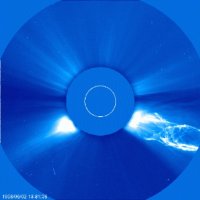Solar Atmosphere
The Sun's atmosphere is faint by visible light but glows brightly in ultraviolet light and X-rays. Emissions at different wavelengths come from gas at different temperatures. Glowing gas, arching along magnetic field lines, makes spectacular prominences that sometimes erupt into space. The outer atmosphere, or corona, is visible as a streaky glow when the Moon eclipses the Sun. Coronagraphs use masks as artificial eclipses to view the corona at any time, without being dazzled by the Sun's bright disk.
Instruments
SOHO carries five instruments for observing the solar atmosphere and corona:
- EIT (Extreme Ultraviolet Imaging Telescope)
- CDS (Coronal Diagnostics Spectrometer)
- SUMER (Solar Ultraviolet Measurements of Emitted Radiation)
- UVCS (Ultraviolet Coronagraph Spectrometer)
- LASCO (Large Angle and Spectrometric Coronagraph)
EIT (Extreme Ultraviolet Imaging Telescope) observes the whole Sun at four different ultraviolet wavelengths. These highlight atmospheric gas at different temperatures, from 80 000 to 2 million degrees, and provide daily weather maps for the Sun.
CDS (Coronal Diagnostics Spectrometer) and SUMER (Solar Ultraviolet Measurements of Emitted Radiation) both scan small areas of the Sun, measuring intensities over a wide range of sharply defined wavelengths. CDS has proved to be especially valuable for deducing temperatures and densities of the gas, while SUMER excels in measuring velocities of gas streams, and detecting previously unknown ultraviolet emissions.
UVCS (Ultraviolet Coronagraph Spectrometer) masks the solar disc to observe and analyse ultraviolet emissions from the corona, from 350 000 to 14 million kilometres above the visible surface. It gauges the energy of atoms leaving the Sun in the solar wind.
LASCO (Large Angle and Spectrometric Coronagraph) observes visible light from the corona in three masked telescopes. Between them, they cover altitudes from 140 000 to 20 million kilometres above the Sun. Mass ejections provide the most spectacular images.
(Another instrument, MDI, observes the visible surface of the Sun and helps scientists to interpret the atmospheric events).
Q & A on the solar atmosphere
What causes flares on the Sun?
EIT confirms what scientists have for long suspected, that magnetic field lines in the solar atmosphere are tangled like spaghetti. A clash of field lines going in opposite directions can result in a magnetic short-circuit - technically, a recombination. A large event of that kind may release energy equivalent to a billion H-bombs. Charged atoms of the solar atmosphere are accelerated. Atoms going downwards heat the lower atmosphere, causing a flare of X-rays, ultraviolet rays and sometimes visible light. Atoms accelerated outwards appear as energetic particles. Scientists would like to be able to predict the events, but so far there is no clear signature of an impending flare.
What causes mass ejections from the Sun?
Almost every day, LASCO observes coronal mass ejections that send millions of tonnes of gas into interplanetary space at some hundreds of kilometres per second. Occasional large mass ejections can release billions of tonnes of gas at 500 to 2000 kilometres per second, and these are the events that attract most attention. Combined results from LASCO and EIT indicate that a mass ejection can originate in an explosion at one end of an arching prominence. CDS has observed the density of gas decreasing in regions feeding the mass ejection, but clear signatures of impending mass ejections remain elusive.
Are harmful mass ejections distinguishable?
Most mass ejections either miss the Earth or are too small to be troublesome. Large ones coming our way appear in the LASCO images as halos around the Sun. But so do other mass ejections heading directly away from us, from the Sun's far side. To avoid a false alarm, scientists check EIT images of the Sun's near side. They look for a shock waves passing though solar atmosphere as a recoil from the mass ejection. When a mass ejection hits SOHO itself, CELIAS measures its speed and density, and so indicates its severity, 30 to 60 minutes before the storm reaches the Earth.
Why is the atmosphere so hot - at 2 million degrees or more?
Thousands of relatively small explosions every day release energy into the atmosphere. SUMER detects the explosions as jets of gas, while CDS sees bright spots called blinkers. The cause of the explosions is evident in an ever-changing carpet of outgoing and ingoing magnetic fields on the Sun's visible surface. As seen by MDI, the magnetic pattern changes completely every 40 hours. The implication is that the tangled loops of magnetic field lines in the atmosphere are continually reorganizing themselves, and in the process provoking the explosions. Whether these magnetic explosions explain all of the atmospheric heating is still debated.
Where does the fast solar wind come from?
The form of the solar wind that fills most of space around the Sun travels at about 750 kilometres per second. This fast wind comes from cool regions of the atmosphere called coronal holes, usually found near the Sun's poles. SUMER, which measures outflows of gas low in the atmosphere, detects streams leaking through the corners of honeycomb-shaped magnetic fields that surround bubbling cells in the visible surface. Gas also spirals outwards in giant tornadoes, observed in the polar regions by CDS, and probably joins the solar wind. UVCS sees charged gas atoms, at greater distances from the visible surface, being accelerated by magnetic waves.
Where does the slow solar wind come from?
The slow solar wind (about 350 kilometres per second) is common in the vicinity of the Earth. It emerges from the hot atmosphere typical of the Sun's equatorial regions. Here loops in the magnetic field impede the escape of gas except at the edges of bright wedge-shaped regions called helmets, as observed by UVCS. LASCO sees many small mass ejections, driven by explosions in the disorderly magnetic regime of the equatorial region. These mass ejections contribute to the solar wind, and LASCO observes gas atoms still being accelerated, perhaps by magnetic waves, at a distance of 20 million kilometres from the visible Sun.

